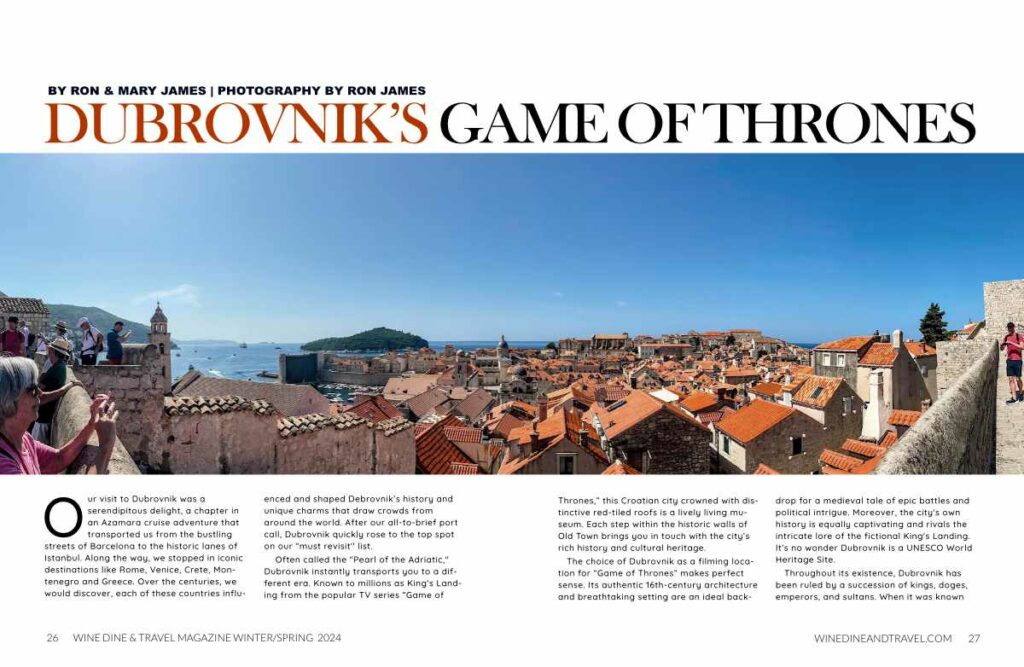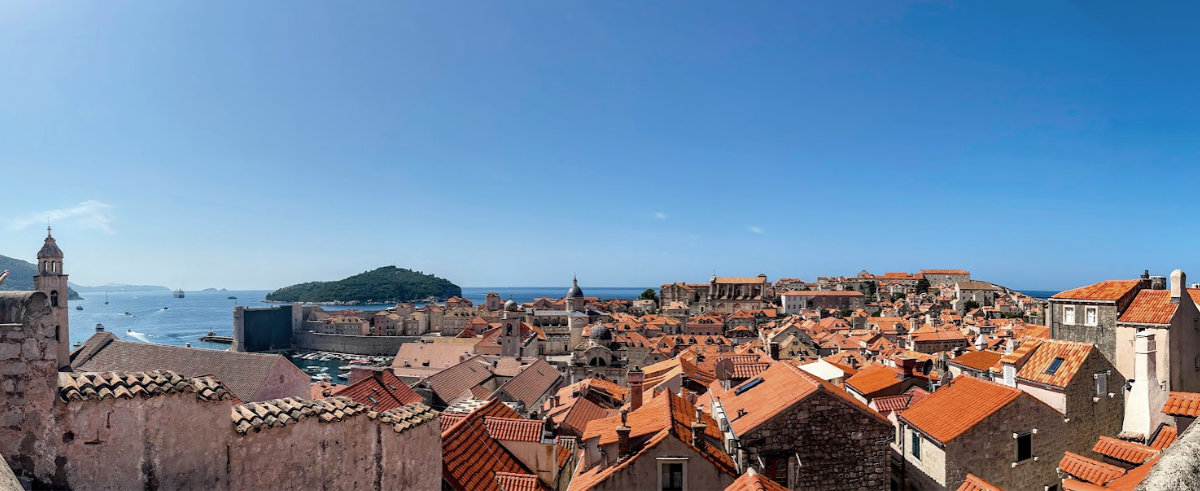By Ron & Mary James
Our visit to Dubrovnik was a serendipitous delight, a chapter in an Azamara cruise adventure that transported us from the bustling streets of Barcelona to the historic lanes of Istanbul. Along the way, we stopped in iconic destinations like Rome, Venice, Crete, Montenegro and Greece. Over the centuries, we would discover, each of these countries influenced and shaped Debrovnik’s history and unique charms that draw crowds from around the world. After our all-to-brief port call, Dubrovnik quickly rose to the top spot on our “must revisit” list./

Often called the “Pearl of the Adriatic,” Dubrovnik instantly transports you to a different era. Known to millions as King’s Landing from the popular TV series “Game of Thrones,” this Croatian city crowned with distinctive red-tiled roofs is a lively living museum. Each step within the historic walls of Old Town brings you in touch with the city’s rich history and cultural heritage.
The choice of Dubrovnik as a filming location for “Game of Thrones” makes perfect sense. Its authentic 16th-century architecture and breathtaking setting are an ideal backdrop for a medieval tale of epic battles and political intrigue. Moreover, the city’s own history is equally captivating and rivals the intricate lore of the fictional King’s Landing. It’s no wonder Dubrovnik is a UNESCO World Heritage Site.
Throughout its existence, Dubrovnik has been ruled by a succession of kings, doges, emperors, and sultans. When it was known as Ragusa, it was conquered by civilizations around the Mediterranean and Adriatic seas, including the Greeks, Carthaginians, Romans, Byzantines, Arabs, Normans, Sicilians, and Venetians. Our arrival by sea into this prominent trade port felt particularly fitting.
Our ship, Azamara Onward, anchored offshore near Lorkrum Island. The modern port of Gruz in Dubrovnik can accommodate two large cruise ships, but it’s not unusual for five ships to converge on the city simultaneously. As a result, many cruisers find themselves coming ashore via tenders. The only potential drawback is the condition of the sea, which on occasion can disrupt and even rule out shore excursions.
Thankfully, our visit was blessed with calm seas, and our tender brought us to the ancient port entrance, a gateway into Dubrovnik’s rich maritime history. Stepping onto the limestone dock there was like entering a time machine. Centuries-old pier walls and lookout towers surrounded a compact harbor. These fortifications are among the largest and best-preserved medieval defensive structures in the world. TripAdvisor has recognized them as one of the top 10 monuments to visit in one’s lifetime.
Today, the Old Port serves as a public marina and the starting point for sightseeing boat tours and ferries to Lokrum Island. One of the most prominent attractions is the Galleon Tirena, a meticulously recreated 16th-century Dubrovnik ship that contributed to the city’s rise as a formidable maritime trading power, rivaling even the Venetians. At its peak in 1800, Dubrovnik’s fleet boasted 670 vessels, including 230 large transoceanic ships, tended by some 7,000 seamen, shipbuilders, and shipowners.
Dubrovnik has witnessed the arrival of many rulers and conquerors, both real and fictional. Fans of Game of Thrones can visit 19 filming locations within the city, with King’s Landing being the most iconic. There are dedicated Game of Thrones tours as well as online resources for self-guided adventures. You’ll also find several Game of Thrones-themed shops where you can indulge in a little fantasy and even sit on the Iron Throne for a memorable Instagram moment.
As we entered the Old Town and strolled the limestone-paved streets, we marveled at the charming Baroque, Gothic, and Renaissance-style buildings – all exceptionally well-preserved. At times, you feel as if you’re wandering through a carefully constructed historical theme park.
Our first stop was the iconic Placa, also known as Stradun Street. This bustling thoroughfare is Dubrovnik’s main promenade, dividing the city into its northern and southern halves. Originally a canal separating two ancient settlements, the area witnessed the merging of Roman and Greek settlers with Croatian-Slav neighbors over time. The street was paved with limestone in 1468, and because of centuries of foot traffic, the surface is remarkably smooth and seriously slippery when wet. The Baroque-style stone houses that line the Placa were erected in 1667 after a devastating earthquake. This unique architecture has become one of Dubrovnik’s most cherished hallmarks.
Walking the streets, we couldn’t help but notice similarities between some buildings and those we had encountered in Venice just a few days earlier. That’s not surprising considering the Venetians had a hand in constructing them. For over a century, the Venetians sought control of the city, finally succeeding in the early 13th century. Before that, the Byzantines had safeguarded Dubrovnik as a vital trading partner. However, the Crusaders’ sacking of Constantinople weakened the Byzantine Empire, leaving Dubrovnik more vulnerable. It wasn’t until 1358 that Louis I of Hungary liberated the city from Venetian rule, granting it independence under his protection.
In Dubrovnik, every building tells a tale. Our guide shared the story of the Church of Saint Blaise, a Baroque-style marvel constructed in 1714 on the site of a 14th-century Romanesque church damaged during the 1667 earthquake. The church is dedicated to Saint Blaise, a Croatian physician, Armenian bishop, and Christian saint.
Legend has it that in 972 AD, Venetian ships appeared near Lokrum Island with the guise of delivering supplies. No one in the city thought much of it at the time. However, while praying in the Church of St. Stephen, a local priest received a visitation from the spirit of St. Blaise. The saint warned of the Venetians’ true intention to conquer the city. The priest promptly alerted the city’s Senate, which prepared for defense.
The Venetians, with their secret scheme revealed, were forced to abandon their mission and set sail. In gratitude for this miraculous intervention, Saint Blaise became the patron saint of Dubrovnik and the protector of the independent Republic of Ragusa. To this day, the city celebrates the Feast of St. Blaise every February 3rd with street celebrations and parades, an event recognized by UNESCO as an “Intangible Cultural Heritage” in 2009.
As the morning sun grew hotter, we realized that one thing Dubrovnik lacked was shade, with few trees or parks within the Old Town. Our guide wisely advised us to refill our water bottles. She led us to the famous Onofrio Fountain, a majestic circular structure built between 1438 and 1440 by Italian architect Onofrio Della Cava. Della Cava was also responsible for an aqueduct system supplying water to Dubrovnik, constructed in 1438, and a plumbing system that transported water from a spring over seven miles away.
Before the aqueduct’s completion, the city relied on rainwater for drinking. The system was relatively simple – rainwater was collected in cisterns – but the cisterns only held only a few weeks’ worth of water. During prolonged droughts, resourceful citizens would fill barrels with fresh water from nearby springs and transport them to the port to sell at inflated prices. In response, city leaders commissioned Della Cava to oversee the construction of the aqueduct that continues to serve the city today.
Della Cava was also responsible for the city’s advanced sewer system, a pioneering endeavor in medieval engineering. The system featured pipes hidden within the walls and included drainage pipes that led rainwater from rooftops through carved stone gargoyle-like faces, spraying water from the buildings. This sewer system significantly impacted the city’s infrastructure and public health over the centuries, a testament to Dubrovnik’s advanced urban planning and public health measures during the medieval period.
Like many other cities, Dubrovnik has its own quirky superstitions and rituals for good luck, happiness, or romance. In this city, it’s the Gargoyle Ritual. As you approach the stairway leading up to the city’s famous walls, it’s not uncommon to see a tourist precariously balancing on a small, stone protrusion from the limestone wall. Shaped like an owl with a mustache and once part of the ancient water system, the protrusion marked the end of a pipe that drained rainwater from the buildings.
The owl spout, known as a mascaron, protrudes barely five inches and stands about a foot above the ground. Years of wear have sloped its top downward, giving it a polished, marble-like slippery surface. The wall above it has become greasy from the touch of countless hands as luck seekers try to jump up and stay on the mascaron while removing their shirts and putting them back on. It’s said that a few have succeeded. We watched one determined young man struggle to stay upright on the stone, let alone disrobe while balancing precariously.
The origins of this ritual remain shrouded in mystery,like many urban traditions. Legend has it that it began with a young man searching for love, vowing that he would only find it once he successfully climbed on the owl, removed his shirt, and put it back on. He persisted for a long time, and when he finally achieved his goal, he found love. From the grease marks on the wall and the sheen on the stone, it’s clear that many have ventured up in search of romantic good fortune.
As we explored Dubrovnik, it seemed every corner of the city had a cameo in “Game of Thrones.” Among the most iconic scenes filmed in Dubrovnik is the “Walk of Shame” from season five, featuring actress Lena Headey as Cersei Lannister. The scene commences at the top of the elegant Baroque Jesuit Staircase, located on the south side of Gundulic Square.
Filming this memorable scene encountered two significant hurdles. City authorities were initially reluctant to allow the portrayal of a naked woman in one of their most iconic locations, citing a policy against “public displays of sexuality.” After some negotiation, the location was shifted to the more easily isolated staircase, ensuring privacy during filming.
Additionally, the actress herself, Lena Headey, expressed reservations about appearing nude for three days in front of a large crew and extras. The solution was to use a body double. Headey performed the walk herself, with a nude body double, Rebecca Van Cleave, walking alongside her. Later, Headey’s head was digitally superimposed onto the body double’s performance.
“Game of Thrones” isn’t the only film or TV series to utilize Dubrovnik as a stunning backdrop. Notable productions include “Star Wars: Episode VIII – The Last Jedi” (2017), where Dubrovnik’s old town was transformed into the coastal casino town of Canto Bight. The city also doubled as the Medieval town of Nottingham in the 2018 movie adaptation of Robin Hood, and Nicolas Cage was filmed here for “The Unbearable Weight of Massive Talent” in 2022. The Netflix series “Vikings: Valhalla” also chose Dubrovnik as a location in the same year, further elevating the city’s status as a cinematic gem.
